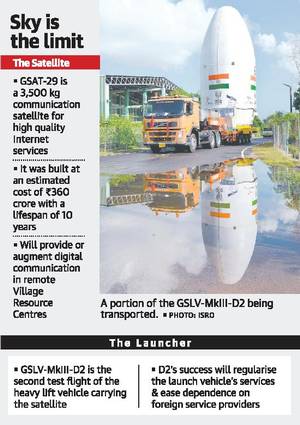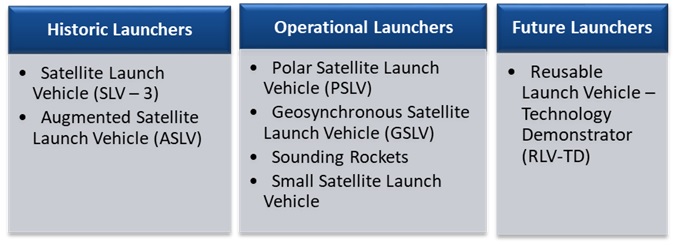Why in news?
ISRO successfully launched GSAT-29 communication satellite on board GSLV-Mk III D2 from the Satish Dhawan Space Centre at Sriharikota.
What are the key features of GSAT-29?
- With a mission life of 10 years, GSAT-29 is the 33rd communication satellite built by ISRO.
- GSAT-29 is a multi-beam, multiband communication satellite.
- Its payloads are designed to mainly focus on connectivity to the users in the hilly and geographically inaccessible areas.
- Weighing 3,423 kg at lift-off, GSAT-29 is the heaviest satellite to be launched from India.
- It will be placed in a geostationary transfer orbit.
- At its closest point it will be 190 km above the Earth, and at its farthest it will be close to 36,000 km above the Earth.
- GSAT-29 also carries a Geo High-Resolution Camera to aid in high-resolution imaging.
- For the first time, an optical communication payload will be utilised for data transmission at a very high rate.
- ISRO’s Master Control facility at Hassan, Karnataka takes over the command and control of GSAT-29 soon after its separation from GSLV Mk III - D2.
- It will be manoeuvred into a geostationary orbit, its final destination, in days.
- Once placed, the satellite’s solar panels and antennae will unfold and work will begin.

- GSLV MK III - The Geosynchronous Satellite Launch Vehicle Mark III is a three-stage heavy lift launch vehicle, weighing 640 tonnes.
- The first stage has two boosters with solid propellant, and the second is the core with liquid propellant.
- The cryogenic engine forms the final stage.
- The GSLV Mk III is the heaviest launch vehicle made in India.
What is the significance?
- The GSLV-GSAT launch enhances India’s capacity to meet its communication needs.
- Both launcher and satellite have certain characteristics that make them unique.
- The launcher can carry payloads up to 4 tonnes to the geosynchronous transfer orbit and up to 10 tonnes to a low-earth orbit.
- The launch shows that ISRO has developed the capability to lift four-tonne payloads using its new GSLV Mark -III rocket.
- The GSLV-III is also likely to be used in the Chandrayaan-II mission in the early months of 2019.
- The multi-band, multi-beam satellite can cater to the communication needs of people in Jammu and Kashmir and the Northeast.
- GSLV MK III - The first successful experimental flight of the GSLV Mk III was in 2014 when it carried a dummy crew module as a payload.
- Its first developmental flight was on June 5, 2017, when it launched GSAT19, weighing 3,136 kg.
- The present launch marked the second developmental flight (D2) of the Mk III.
- With these two successes, the developmental phase of the GSLV Mk III vehicle programme will be complete.
- The launcher is declared ‘operational’ and joins the ranks of the working vehicles, the PSLV and the GSLV.
- This is far fewer than the number of developmental flights the older launch vehicles were subjected to.
- It sets the stage for trying out variations such as other types of engines, different fuel combinations and higher launch capacities.
- The GSLV Mk III has also restored morale at ISRO, which had been dented by the GSAT 6A setback.

Source: The Hindu, Business Standard

